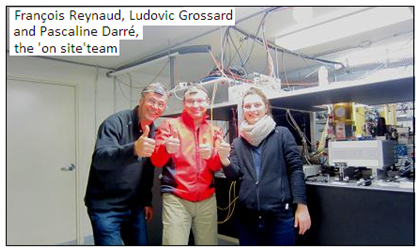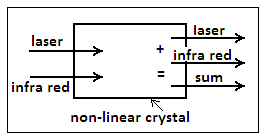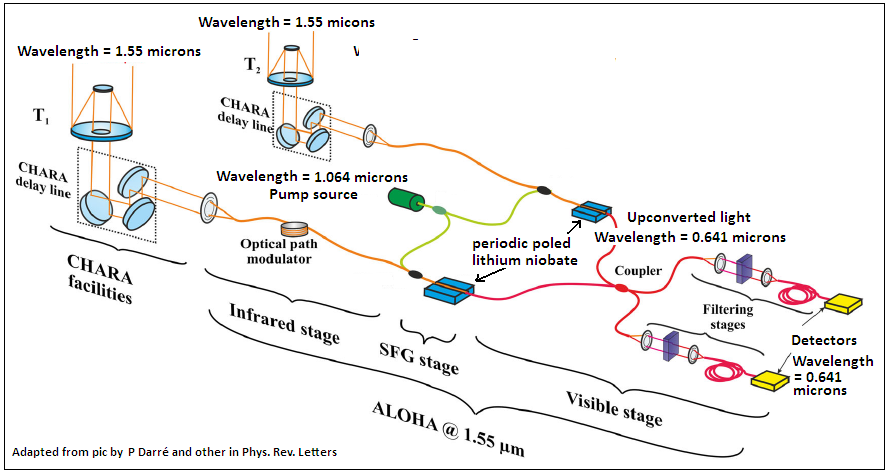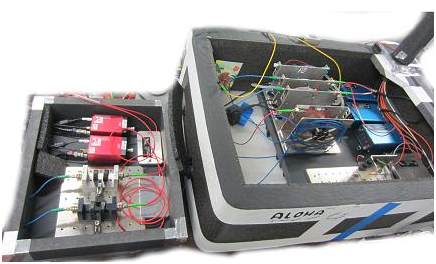Being able to see in the infrared would give us a clearer view of far off worlds, says S.Ananthanarayanan.
A large part of information about the distant universe comes to us in the form of infrared radiation. This is because many bodies in outer space are covered by clouds which are opaque to light in the visible part of the spectrum. Apart from this, it is only in the infrared that any light can reach us over very large distances, as light of higher frequencies is scattered more that light in the infrared
The trouble with seeing in the infrared, however, is that images in the infrared, even in telescopes with very large lenses or mirrors, cannot bring out the details of the objects being seen. This is because the longer wavelength of infrared light does not allow grain size of the images formed to be fine enough for clarity. The solution is hence to form images not with the help of large lenses or mirrors, but by mimicking a very large light collecting area with separate telescopes placed hundreds of metres apart. The different signals, however, then need to be brought together and analysed, a process that presents many challenges, compared to dealing with visible light.
P. Darré, R. Baudoin, J.-T. Gomes, N. J. Scott, L. Delage, L. Grossard, J. Sturmann, C. Farrington, F. Reynaud, and T. A. Ten Brummelaar, of a group of labs in the National Centre for Scientific Research (CNRS) at Limoges, in France and the Mount Wilson Observatory, California, report in the journal, Physical Review Letters, an effective method of converting the infrared light into light in the visible spectrum, without loss of essential features, which enables more efficient retrieval of information

In the method of using widely separated telescopes, the waves striking different telescopes in the array arrive at slightly different stages of vibration when they are brought together. The different stages of vibration of the waves, known as ‘phase’, causes them to interfere, and this results in a series of bright and dark fringes, from which phase information can be inferred, and managed. Working with the infrared, however, calls for special optics that is transparent to light in the infrared and what is more challenging, keeping the signal free of unwanted radiation, because all warm objects radiate in the infrared. Much of the arrangement, hence, has to be cooled to cryogenic temperatures.
This is the reason that methods of converting infrared radiation to visible light, without destroying the information of ‘phase’ or the stage of vibration, which enables the structure of the distant object to be assembled, has been of great interest. Handling signals in visible light, both for transmission as well as for detection, is much easier, as photons of visible light affect photo sensors more powerfully. Very efficient and low noise detectors are hence available for detecting visible light. And it is not only in astronomy, but also in chemical analyses and detecting minute gas concentration for environmental monitoring that mid-infrared conversion has now become important.
Upconversion
The possibility of the process of ‘upconversion’ arose with the development of lasers, which can provide the intense beam of coherent light, or a beam of light waves that are all in phase, which is used to combine with incident infrared photons. The infrared light is mixed with an intense laser beam which is in the near infrared or visible region. The mixing is carried out in a cell made of a material in which the effect of the absorption of photons is not only the emission of equal photons, but can also be the emission of a photon with the sum of the energy of two photons, a process called Sum Frequency Generation (SFG). One of the methods used is with crystals of such a material, which shows special properties while passing light, in the form of slivers that are arranged one on the other, with opposed optical properties, a process called periodic poling. This kind of arrangement, known as a non-linear crystal, brings about the adding together of the energy of a far or mid infrared photon and the near infrared or visible photon from the laser, to give rise to a photon with the sum of the two frequencies, in the visible region.

The team writing in Phys. Ref. Letters made use of crystals of periodically poled lithium niobate and passed an infrared beam of wavelength 1.55 microns, and a ‘pump’ laser beam, in the near infra red, with wavelength of 1.064 microns through the crystal stack. The result was light at a combined, shorter wavelength of only 0.631 microns, or 631 nanometres, visible, red-orange region photons with exactly the sum of the energy of the two mother photons. The principle of the conversion is that as the pump photons are in phase, the product photons, in the visible region, retain the phase of the converted, original infrared photons. In the case of photons that arose from two telescopes imaging a distant, stellar object, we would now have a pair of visible light photons, with which to carry out manipulation, but with the more powerful tools that we have for the visible region. As the final light is in the visible region and arises only from the combination of specific wavelengths that is fed in, there is little scope for other, ‘noisy’ radiation.

The arrangement used by the researchers is called Astronomical Light Optical Hybrid Analysis (ALOHA) and consists, as the paper in Phys. Rev. Letters says, of a pair of 1 metre diameter infrared telescopes, 34 metres apart, at the Center for High Angular Resolution Astronomy (CHARA) of Georgia State University, located at the Mount Wilson Observatory, California.
The infrared signals were then channeled to the 22 mm long lithium niobate cells in a laboratory adjacent to the telescopes. The visible light signals that emerged were then brought together and filtered, to eliminate left over pump laser light and also its harmonics, before being passed on to the detectors.The paper goes on to describe the corrections and refinements applied, resulting in confirmation that the infrared signals from the northern-most of the two ‘pointers’ in the Great Bear constellation, had been effectively upconverted into the visible region , with phase intact, as the interference of the signals in visible light was detected. Apart from this being a proof of principle result, the papers says even fainter sources have been detected as also real stars with results comparable with the best so far. In the implementation of ALOHA, the upconversion stage could be kept even much closer to the telescope focus, which would eliminate all extraneous signal from the equipment, the paper says. Even the optical path regulating equipment, which was used before the upconversion stage (see picture) could be placed after the upconversion, as phase information was maintained in the upconversion process, the paper says.
d infrared photon and the near infrared or visible photon from the laser, to give rise to a photon with the sum of the two frequencies, in the visible region.
The development, in opening the possibility of the use of efficient visible light optics to the infra red, is a seminal one, the paper says, and this would extend the utility of great advances already made in visible light optics and detectors to sensitive investigation of low energy processes.
------------------------------------------------------------------------------------------